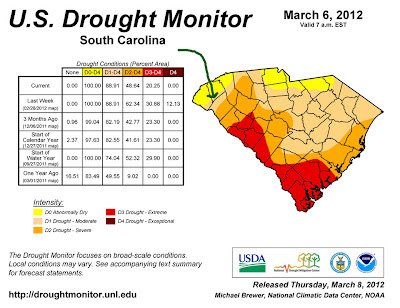Drought and water use
There was an article in the paper this morning about continuing dry conditions in Upstate South Carolina. It reminded me - again - that water use for landscapes may be problematic in the future. The arrow on this map shows where I garden in the Piedmont.
We're between abnormally dry and moderate drought.
Normally, we get around 50 inches of rain a year, spread evenly throughout the year, with a bit less in the late summer and fall. But it's highly variable, and we came out of a decade-long extreme drought not that long ago, so the prospects are always worrisome.
I drafted a "Gardening Green" piece for the newsletter (from the botanical garden where I work) this morning about saving water in the landscape.
Aside from vegetables, which are water and nutrient hogs, it's hard to justify supplemental water for landscape plants, when there are so many great options that don't need extra water. Even if one can afford the cost of water, it doesn't seem right if you're trying to be a sustainable gardener.
In my piece, I mentioned traditionally-used 'Southern' plants such as Camellias and Crape Myrtles. These were introduced long before landscape irrigation was a common practice, so they're survivors, through dry times and wet. And, of course, there are a lot of drought-tolerant native trees and shrubs to choose from, too.
We're between abnormally dry and moderate drought.
Normally, we get around 50 inches of rain a year, spread evenly throughout the year, with a bit less in the late summer and fall. But it's highly variable, and we came out of a decade-long extreme drought not that long ago, so the prospects are always worrisome.
I drafted a "Gardening Green" piece for the newsletter (from the botanical garden where I work) this morning about saving water in the landscape.
Aside from vegetables, which are water and nutrient hogs, it's hard to justify supplemental water for landscape plants, when there are so many great options that don't need extra water. Even if one can afford the cost of water, it doesn't seem right if you're trying to be a sustainable gardener.
In my piece, I mentioned traditionally-used 'Southern' plants such as Camellias and Crape Myrtles. These were introduced long before landscape irrigation was a common practice, so they're survivors, through dry times and wet. And, of course, there are a lot of drought-tolerant native trees and shrubs to choose from, too.

Lisa,
ReplyDeleteYour post has resonance over here.
Last year was the driest in 90 years for Nottinghamshire and the drought continues.
Beth Chatto wrote 'The Dry Garden'in 1978 and has developed a garden in dry eastern England that we hope to visit later this year. We hope to learn from her when we visit.
The answer is not irrigation!!
Rob
Rob,
ReplyDeleteI was fortunate to see her 'dry garden' a couple of years ago.
Remarkable, and well worth a visit. I have a copy of The Dry Garden, but haven't perused it thoroughly -- it's all about matching the right plants to our conditions, for sure.
Lisa